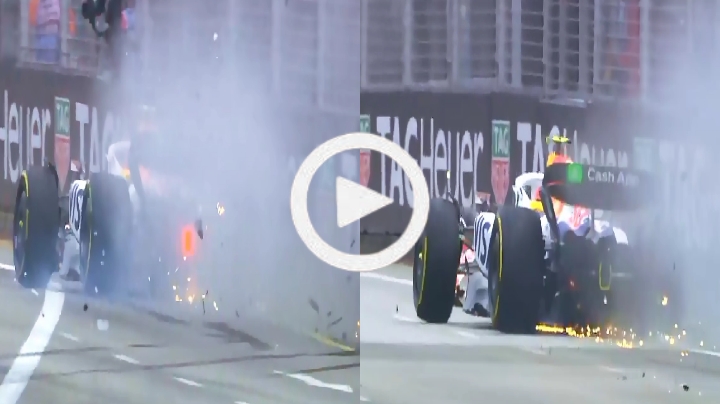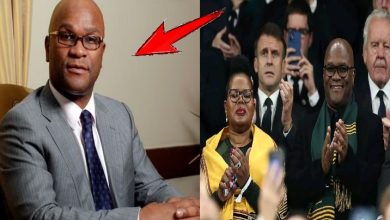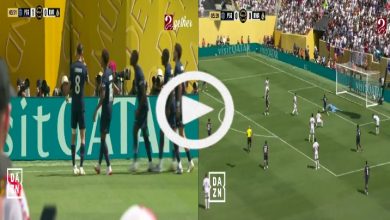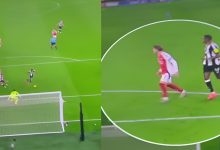Liam Lawson’s Singapore Crash Chaos: FP3 Red Flag Drama at Marina Bay – Formula 1 2025

The 2025 Formula 1 Singapore Grand Prix weekend delivered yet another unforgettable moment — and for all the wrong reasons for Liam Lawson. During the final practice session (FP3), the New Zealand driver was involved in a heavy crash at Turn 7, bringing out the red flag and halting the session at the Marina Bay Street Circuit.
What was expected to be a clean final practice before qualifying turned into a dramatic scene of carbon fiber debris, flashing red lights, and tense radio messages. The incident marks Lawson’s second crash in Singapore this weekend after a smaller impact in FP2, raising serious questions about the car setup, tire performance, and the driver’s confidence heading into one of the most challenging races on the F1 calendar.
You can watch the full crash and FP3 highlights here → Watch Video on YouTube
The Build-Up to FP3: Pressure and Heat in Singapore
Heading into FP3, teams were already struggling to find the right balance between grip and tire wear on Singapore’s notoriously demanding street circuit. The Marina Bay track, surrounded by the glowing skyline and humid night air, punishes the smallest mistakes.
Lawson, driving for RB (formerly AlphaTauri), had impressed in earlier sessions this season with solid performances, but Singapore was proving to be his toughest challenge yet. After clipping the wall in FP2, the team worked late into the night to repair the car. The goal was clear — get valuable long-run data before qualifying.
However, only 15 minutes into FP3, things went terribly wrong.
The Crash: What Happened at Turn 7
On a flying lap, Lawson approached Turn 7, a medium-speed left-hander that has claimed several victims over the years. The telemetry data shows he entered the corner slightly faster than the optimal speed, with the rear of the car losing traction mid-turn.
The RB’s rear snapped violently, and Lawson tried to correct it, but it was too late. The car slid across the track and slammed into the barriers on the outside of Turn 7. The impact was strong enough to rip off the front suspension and scatter debris across the racing line.
“I just lost the rear, sorry guys,” Lawson said over team radio moments after the impact — his voice clearly frustrated but calm. The red flags were immediately deployed as marshals rushed to clear the wreckage.
Red Flag and Session Halted
With pieces of the RB scattered across the track and the barrier needing repair, the stewards had no choice but to red flag the session. The stoppage lasted for nearly 20 minutes while the track marshals cleared debris and reset the safety barriers.
The crash also disrupted the plans of several other teams, including Ferrari, Mercedes, and McLaren, who were in the middle of crucial qualifying simulations. For teams already struggling with tire temperatures, the sudden stoppage added another layer of complexity to the weekend.
When the session resumed, few drivers were able to improve their times significantly, leaving the final practice somewhat inconclusive ahead of qualifying.
Damage Assessment: The Cost of a Crash
The immediate concern after any crash is always the driver’s safety. Fortunately, Lawson walked away unharmed. However, the damage to the car was extensive — front suspension failure, a destroyed nose, and possible chassis impact.
Team RB mechanics faced an uphill battle to get the car ready for qualifying just hours later. Under the tight Formula 1 parc fermé conditions, any major component replacement could lead to penalties, depending on what was damaged.
Sources from the paddock revealed that the team was assessing whether the gearbox or power unit suffered any damage from the collision. If either component was compromised, Lawson could face a grid penalty — a costly outcome in a race where overtaking is notoriously difficult.
The Psychological Impact on Lawson
For any driver, especially one trying to prove himself in a competitive field, two crashes in the same weekend can shake confidence. Yet, those who know Lawson describe him as mentally resilient — a driver who thrives under pressure.
Former F1 driver and Sky Sports commentator Karun Chandhok noted during coverage:
“Lawson’s crash was unfortunate, but this is Singapore — a tiny mistake here gets punished heavily. What matters is how he bounces back in qualifying.”
Indeed, Singapore has historically been brutal on rookies and rising stars. Even world champions like Lewis Hamilton, Sebastian Vettel, and Fernando Alonso have all had their share of close calls at Marina Bay.
For Lawson, this crash will test not only his driving skill but also his ability to recover mentally and perform when it matters most — under the lights in qualifying.
Reactions from the Paddock
After the session, social media buzzed with clips of the crash. Fans and pundits alike debated whether it was driver error or setup misjudgment.
- “Lawson pushing too hard too early,” wrote one fan on X (formerly Twitter).
- “Track evolution caught him out, rear grip just disappeared,” commented another.
Team principal Peter Bayer defended Lawson, saying:
“He was finding the limits, as all drivers do in FP3. Singapore doesn’t forgive errors, but we stand behind him completely. We’ll rebuild and move forward.”
This public support could prove crucial as Lawson fights to secure a full-time seat for next season.
Historical Context: Turn 7’s Reputation
Turn 7 at Marina Bay has a long history of catching drivers out. The combination of changing track temperatures, uneven asphalt, and low-grip conditions make it one of the trickiest corners in Formula 1.
Over the years, notable incidents include:
- Nico Rosberg (2016): Lost the rear in wet conditions.
- Romain Grosjean (2018): Clipped the wall during qualifying.
- George Russell (2023): Crashed while chasing a podium on the final lap.
Lawson’s incident now joins that list — another reminder of how unforgiving this section can be.
Impact on Qualifying and Race Strategy
The crash leaves RB with limited data ahead of qualifying. Without proper long-run simulation, the team might struggle with tire management during the race — a critical factor on a track known for high degradation and limited overtaking opportunities.
Additionally, a potential gearbox or chassis change could result in starting from the back of the grid. That would force the team to adopt an aggressive pit strategy or rely on potential Safety Cars, which are common in Singapore races.
The Broader Picture: F1’s Toughest Street Circuit
The Singapore Grand Prix remains one of the crown jewels of the F1 calendar — a race that tests every aspect of a team’s preparation. With humidity near 80%, air temperatures over 30°C, and a track lined with concrete walls, even the smallest error can end a weekend.
As Formula 1 continues to expand its global reach, Singapore remains a fan favorite for its night-time spectacle, unpredictable races, and iconic skyline backdrop. For drivers like Lawson, it represents both opportunity and danger in equal measure.
What’s Next for Liam Lawson?
Despite the setback, many in the paddock still view Lawson as one of the most promising young drivers on the grid. His raw pace, aggressive style, and adaptability have been evident throughout the season.
If he can regroup and deliver a strong qualifying performance, this crash could become just another learning moment in his growing career. However, if the crash damage limits his running, it may be a long and difficult Sunday under the Singapore lights.
With several teams evaluating driver options for 2026, every lap matters — and Lawson knows it.
Final Thoughts
Crashes are part of the sport, but the Liam Lawson Singapore FP3 crash serves as a stark reminder of how fine the margins are in Formula 1. At speeds exceeding 250 km/h, one small mistake can turn precision into chaos in a heartbeat.
As the 2025 Singapore Grand Prix weekend continues, all eyes will be on Lawson and how he responds. Redemption is always possible — especially for drivers with something to prove.
Watch the full crash and FP3 highlights on YouTube here:








